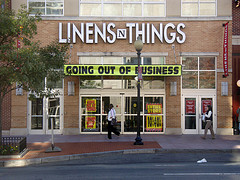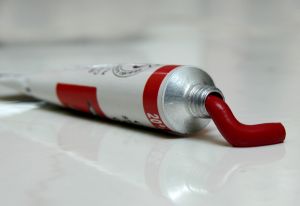 There’s a new trend in the branding world (well, not entirely new, but certainly growing in popularity lately) — reviving brand names from the depths of bankruptcy (via the New York Times). Recently, Linens ‘n Things, Sharper Image, Bombay, Halston, and CompUSA have all been given a second chance at life — albeit a shadowy version of their former lives — thanks to liquidators (they prefer to be called “asset recovery specialists”).
There’s a new trend in the branding world (well, not entirely new, but certainly growing in popularity lately) — reviving brand names from the depths of bankruptcy (via the New York Times). Recently, Linens ‘n Things, Sharper Image, Bombay, Halston, and CompUSA have all been given a second chance at life — albeit a shadowy version of their former lives — thanks to liquidators (they prefer to be called “asset recovery specialists”).
So what exactly is going on?
Well-known brands that are victims of corporate bankruptcy are being sold for millions of dollars to help pay creditors as part of the bankruptcy process. Liquidators see value in buying these brand names (Fortunoff and Circuit City are rumored to be next on the list), and then slapping them on new merchandise from different manufacturers. They’re trying to leverage the intrinsic value in the brand names in consumers’ minds.
The ethical question is this — is it fair to offer consumers products with a brand name on them that they associate with a certain value and expectation, which might not actually have the same quality, etc.?
Bankruptcy courts claim the process of selling brand names is valid, because creditors should have every opportunity available to them to recoup their money. So far, consumer rights activists aren’t stepping up to oppose the practice of transferring brand names in this way. What do you think?
Image: Flickr
Susan Gunelius is the author of 10 marketing, social media, branding, copywriting, and technology books, and she is President & CEO of KeySplash Creative, Inc., a marketing communications company. She also owns Women on Business, an award-wining blog for business women. She is a featured columnist for Entrepreneur.com and Forbes.com, and her marketing-related articles have appeared on websites such as MSNBC.com, BusinessWeek.com, TodayShow.com, and more.
She has over 20 years of experience in the marketing field having spent the first decade of her career directing marketing programs for some of the largest companies in the world, including divisions of AT&T and HSBC. Today, her clients include large and small companies around the world and household brands like Citigroup, Cox Communications, Intuit, and more. Susan is frequently interviewed about marketing and branding by television, radio, print, and online media organizations, and she speaks about these topics at events around the world. You can connect with her on Twitter, Facebook, LinkedIn, or Google+.



Susan,
i am always a little bit suspicious of the practice of ‘reviving’ brand names. I want to believe that a thoughtful and insightful company could find a way to re-animate the brand by attaching it to products and experiences that express the brand’s identity as well as (or better than) the original incarnation. For example, I’d love it if someone could bring back the Laura Ashley of the early & mid-1990s… and fix the problems of ever-extension and bad financial management that ultimately brought that brand to its knees.
However, this doesn’t seem to happen very often — lack of creativity gets in the way, as does the probably real problem of re-creating a profitable business where one has already failed for good (e.g., product-related) reasons. If the failure was due to an unappealing brand itself, then it’s hard to imagine how it could be revived effectively.
Even worse, I think, is to take a venerable brand name and attach it to something quite differnt (and often not as good) in an effort to add some patina of fake authenticity to a business (can you say “Abercrombie & Fitch”?).
I don’t think it’s good business practice to use a brand name to cover over inferior products and services. Not only does this degrade the value of the brand over time, but also it sets the consumer up for disappointment right after the purchase, when the product’s inferiority is discovered. That’s bad business.